Analysis of Road Congestion in Australia: An Economics Report
VerifiedAdded on 2023/06/07
|8
|2032
|239
Report
AI Summary
This economics report provides a comprehensive analysis of road congestion in Australia. It begins by defining congestion and outlining its increasing prevalence, citing statistics on the financial costs to businesses and the average time wasted by motorists. The report then delves into the economic theory of externalities, using a figure to illustrate the impact of congestion on market equilibrium, including deadweight loss and external costs. The core of the report analyzes three potential policies to reduce congestion: congestion charging, improving transport substitutes like public transport, and building more roads. Each policy is evaluated for its benefits and costs, considering its effectiveness in reducing congestion, generating revenue, and addressing social costs. The report concludes by suggesting congestion charging as a potentially effective solution, while acknowledging the challenges in its implementation and emphasizing the need for a strong backing to all the proposed policies to ensure effectiveness.
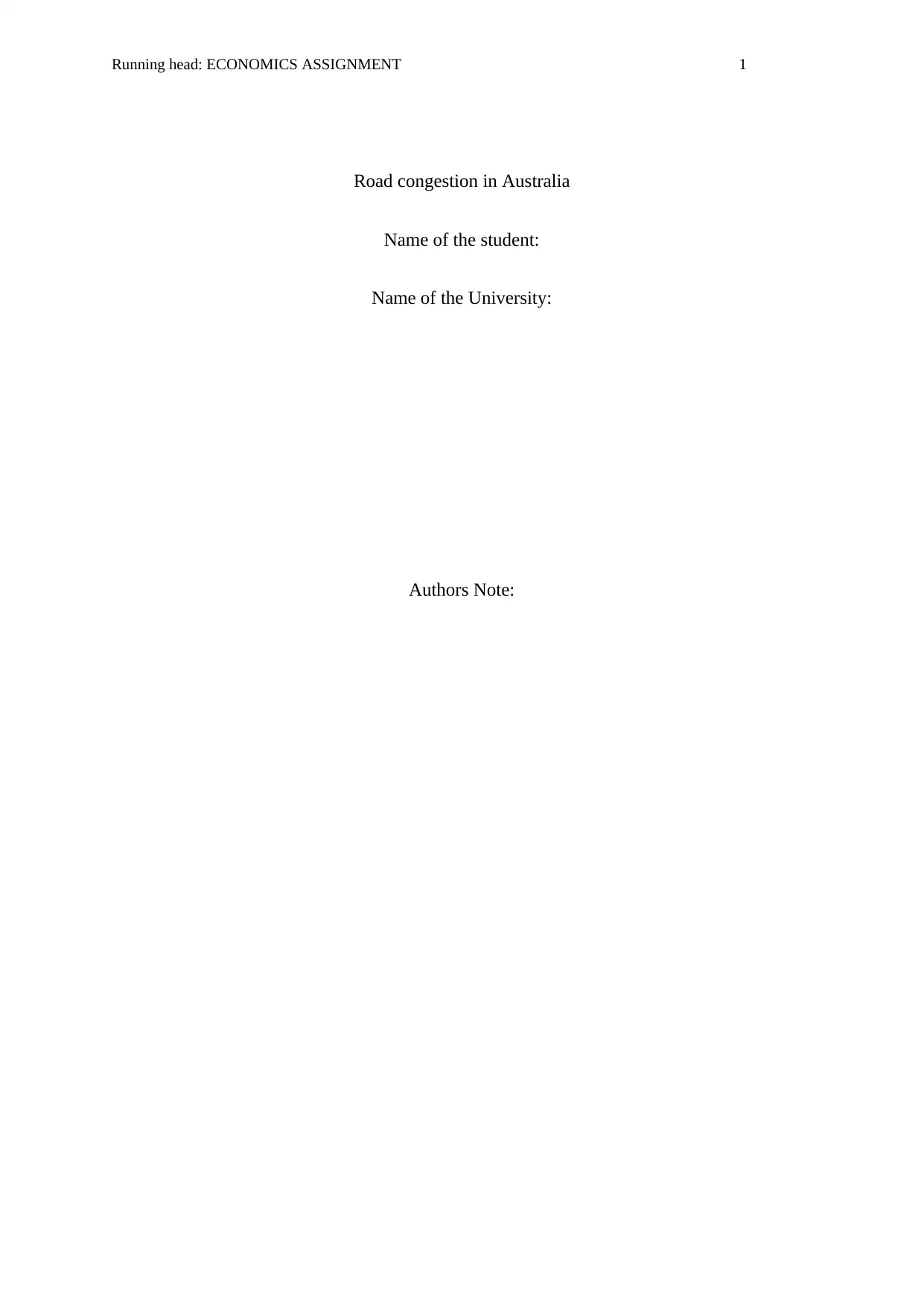
Running head: ECONOMICS ASSIGNMENT 1
Road congestion in Australia
Name of the student:
Name of the University:
Authors Note:
Road congestion in Australia
Name of the student:
Name of the University:
Authors Note:
Paraphrase This Document
Need a fresh take? Get an instant paraphrase of this document with our AI Paraphraser
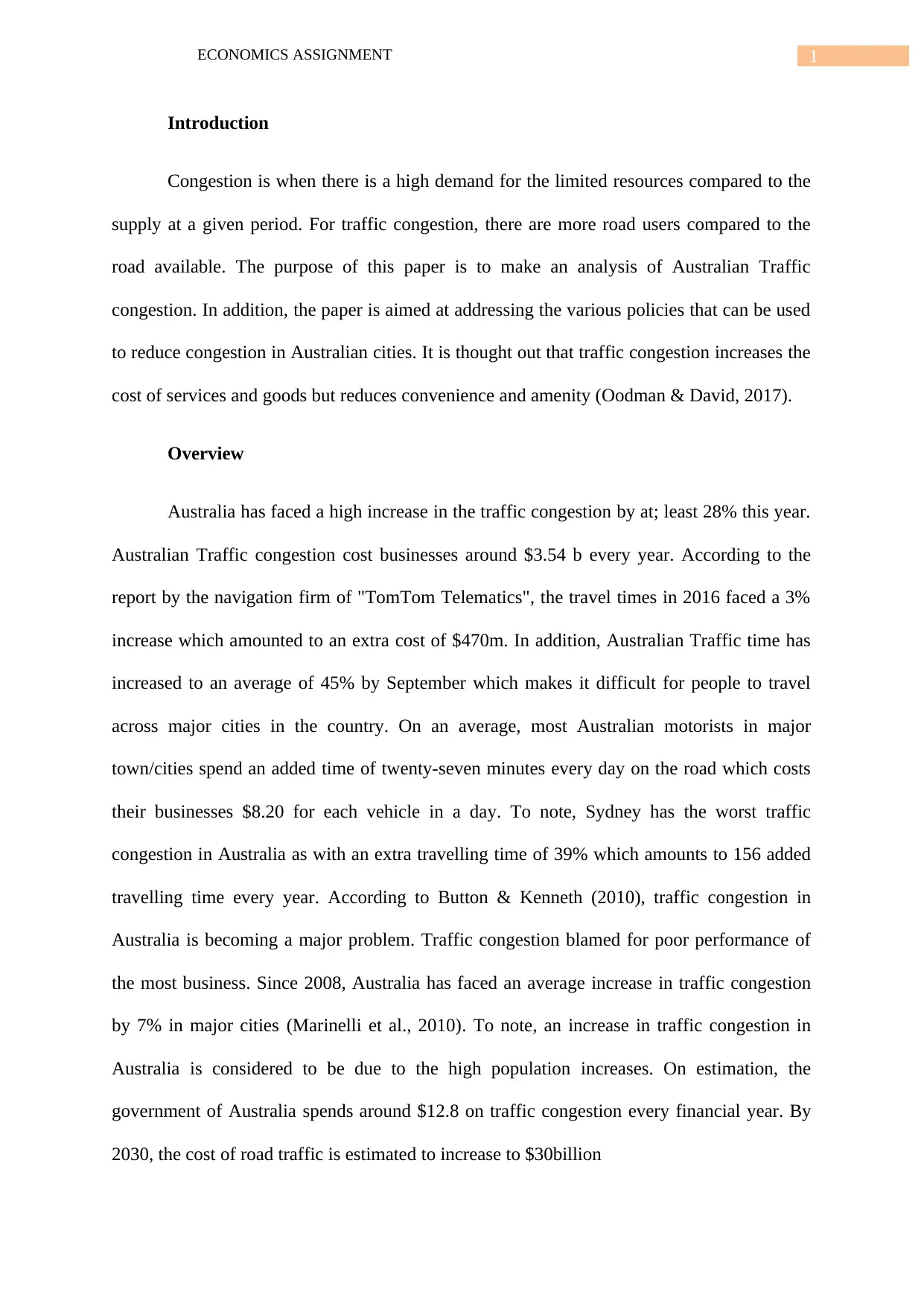
1ECONOMICS ASSIGNMENT
Introduction
Congestion is when there is a high demand for the limited resources compared to the
supply at a given period. For traffic congestion, there are more road users compared to the
road available. The purpose of this paper is to make an analysis of Australian Traffic
congestion. In addition, the paper is aimed at addressing the various policies that can be used
to reduce congestion in Australian cities. It is thought out that traffic congestion increases the
cost of services and goods but reduces convenience and amenity (Oodman & David, 2017).
Overview
Australia has faced a high increase in the traffic congestion by at; least 28% this year.
Australian Traffic congestion cost businesses around $3.54 b every year. According to the
report by the navigation firm of "TomTom Telematics", the travel times in 2016 faced a 3%
increase which amounted to an extra cost of $470m. In addition, Australian Traffic time has
increased to an average of 45% by September which makes it difficult for people to travel
across major cities in the country. On an average, most Australian motorists in major
town/cities spend an added time of twenty-seven minutes every day on the road which costs
their businesses $8.20 for each vehicle in a day. To note, Sydney has the worst traffic
congestion in Australia as with an extra travelling time of 39% which amounts to 156 added
travelling time every year. According to Button & Kenneth (2010), traffic congestion in
Australia is becoming a major problem. Traffic congestion blamed for poor performance of
the most business. Since 2008, Australia has faced an average increase in traffic congestion
by 7% in major cities (Marinelli et al., 2010). To note, an increase in traffic congestion in
Australia is considered to be due to the high population increases. On estimation, the
government of Australia spends around $12.8 on traffic congestion every financial year. By
2030, the cost of road traffic is estimated to increase to $30billion
Introduction
Congestion is when there is a high demand for the limited resources compared to the
supply at a given period. For traffic congestion, there are more road users compared to the
road available. The purpose of this paper is to make an analysis of Australian Traffic
congestion. In addition, the paper is aimed at addressing the various policies that can be used
to reduce congestion in Australian cities. It is thought out that traffic congestion increases the
cost of services and goods but reduces convenience and amenity (Oodman & David, 2017).
Overview
Australia has faced a high increase in the traffic congestion by at; least 28% this year.
Australian Traffic congestion cost businesses around $3.54 b every year. According to the
report by the navigation firm of "TomTom Telematics", the travel times in 2016 faced a 3%
increase which amounted to an extra cost of $470m. In addition, Australian Traffic time has
increased to an average of 45% by September which makes it difficult for people to travel
across major cities in the country. On an average, most Australian motorists in major
town/cities spend an added time of twenty-seven minutes every day on the road which costs
their businesses $8.20 for each vehicle in a day. To note, Sydney has the worst traffic
congestion in Australia as with an extra travelling time of 39% which amounts to 156 added
travelling time every year. According to Button & Kenneth (2010), traffic congestion in
Australia is becoming a major problem. Traffic congestion blamed for poor performance of
the most business. Since 2008, Australia has faced an average increase in traffic congestion
by 7% in major cities (Marinelli et al., 2010). To note, an increase in traffic congestion in
Australia is considered to be due to the high population increases. On estimation, the
government of Australia spends around $12.8 on traffic congestion every financial year. By
2030, the cost of road traffic is estimated to increase to $30billion
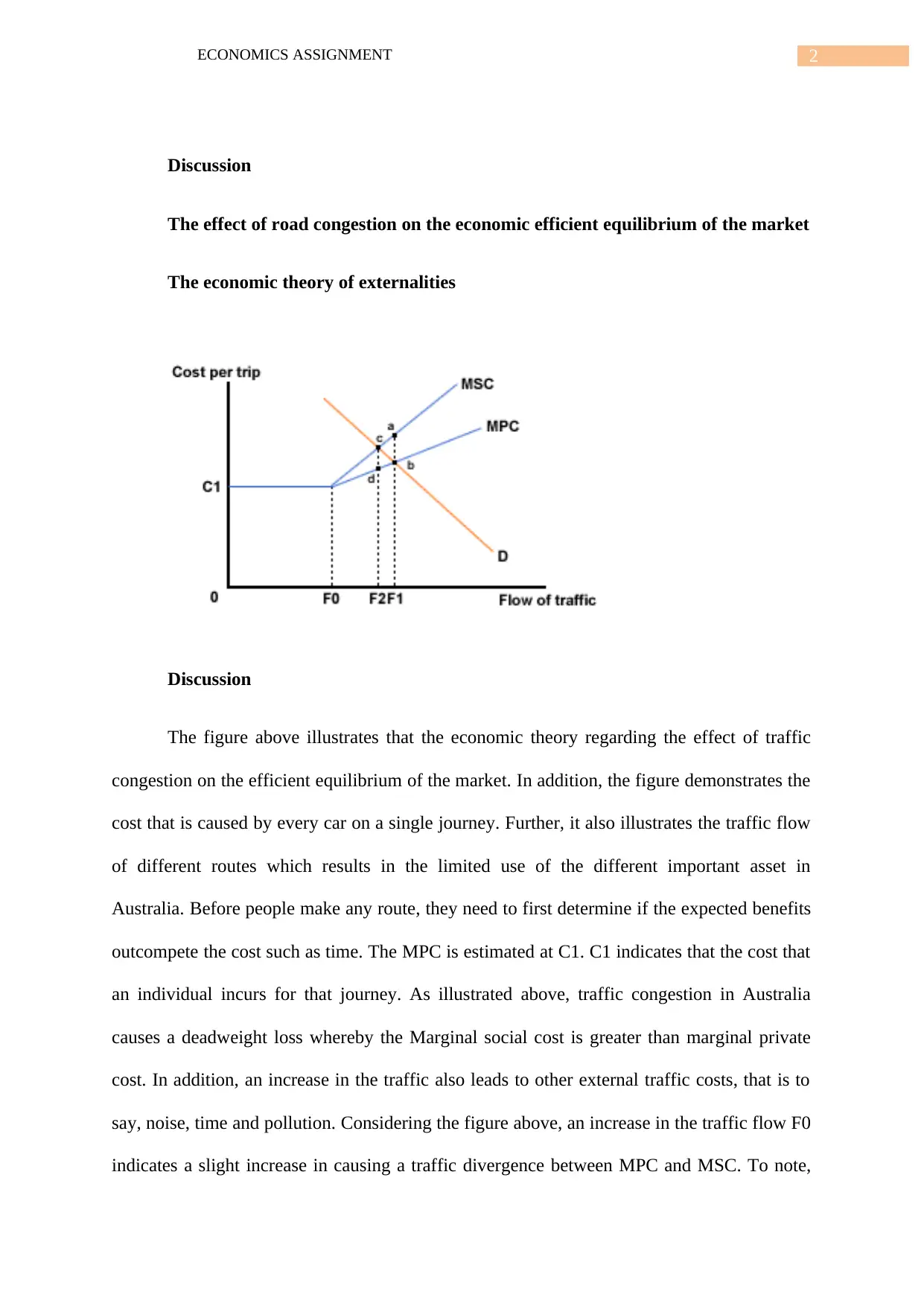
2ECONOMICS ASSIGNMENT
Discussion
The effect of road congestion on the economic efficient equilibrium of the market
The economic theory of externalities
Discussion
The figure above illustrates that the economic theory regarding the effect of traffic
congestion on the efficient equilibrium of the market. In addition, the figure demonstrates the
cost that is caused by every car on a single journey. Further, it also illustrates the traffic flow
of different routes which results in the limited use of the different important asset in
Australia. Before people make any route, they need to first determine if the expected benefits
outcompete the cost such as time. The MPC is estimated at C1. C1 indicates that the cost that
an individual incurs for that journey. As illustrated above, traffic congestion in Australia
causes a deadweight loss whereby the Marginal social cost is greater than marginal private
cost. In addition, an increase in the traffic also leads to other external traffic costs, that is to
say, noise, time and pollution. Considering the figure above, an increase in the traffic flow F0
indicates a slight increase in causing a traffic divergence between MPC and MSC. To note,
Discussion
The effect of road congestion on the economic efficient equilibrium of the market
The economic theory of externalities
Discussion
The figure above illustrates that the economic theory regarding the effect of traffic
congestion on the efficient equilibrium of the market. In addition, the figure demonstrates the
cost that is caused by every car on a single journey. Further, it also illustrates the traffic flow
of different routes which results in the limited use of the different important asset in
Australia. Before people make any route, they need to first determine if the expected benefits
outcompete the cost such as time. The MPC is estimated at C1. C1 indicates that the cost that
an individual incurs for that journey. As illustrated above, traffic congestion in Australia
causes a deadweight loss whereby the Marginal social cost is greater than marginal private
cost. In addition, an increase in the traffic also leads to other external traffic costs, that is to
say, noise, time and pollution. Considering the figure above, an increase in the traffic flow F0
indicates a slight increase in causing a traffic divergence between MPC and MSC. To note,
⊘ This is a preview!⊘
Do you want full access?
Subscribe today to unlock all pages.

Trusted by 1+ million students worldwide
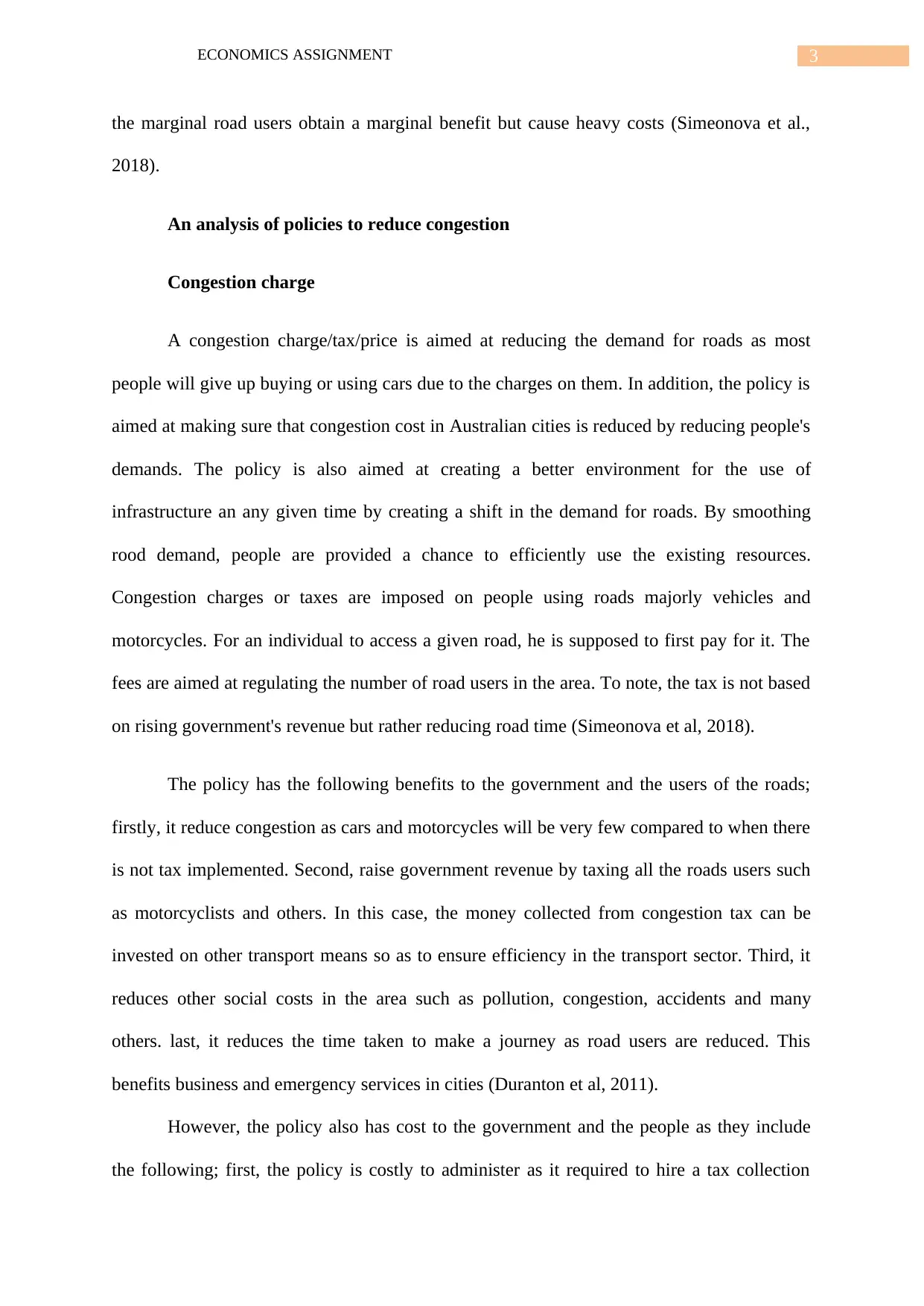
3ECONOMICS ASSIGNMENT
the marginal road users obtain a marginal benefit but cause heavy costs (Simeonova et al.,
2018).
An analysis of policies to reduce congestion
Congestion charge
A congestion charge/tax/price is aimed at reducing the demand for roads as most
people will give up buying or using cars due to the charges on them. In addition, the policy is
aimed at making sure that congestion cost in Australian cities is reduced by reducing people's
demands. The policy is also aimed at creating a better environment for the use of
infrastructure an any given time by creating a shift in the demand for roads. By smoothing
rood demand, people are provided a chance to efficiently use the existing resources.
Congestion charges or taxes are imposed on people using roads majorly vehicles and
motorcycles. For an individual to access a given road, he is supposed to first pay for it. The
fees are aimed at regulating the number of road users in the area. To note, the tax is not based
on rising government's revenue but rather reducing road time (Simeonova et al, 2018).
The policy has the following benefits to the government and the users of the roads;
firstly, it reduce congestion as cars and motorcycles will be very few compared to when there
is not tax implemented. Second, raise government revenue by taxing all the roads users such
as motorcyclists and others. In this case, the money collected from congestion tax can be
invested on other transport means so as to ensure efficiency in the transport sector. Third, it
reduces other social costs in the area such as pollution, congestion, accidents and many
others. last, it reduces the time taken to make a journey as road users are reduced. This
benefits business and emergency services in cities (Duranton et al, 2011).
However, the policy also has cost to the government and the people as they include
the following; first, the policy is costly to administer as it required to hire a tax collection
the marginal road users obtain a marginal benefit but cause heavy costs (Simeonova et al.,
2018).
An analysis of policies to reduce congestion
Congestion charge
A congestion charge/tax/price is aimed at reducing the demand for roads as most
people will give up buying or using cars due to the charges on them. In addition, the policy is
aimed at making sure that congestion cost in Australian cities is reduced by reducing people's
demands. The policy is also aimed at creating a better environment for the use of
infrastructure an any given time by creating a shift in the demand for roads. By smoothing
rood demand, people are provided a chance to efficiently use the existing resources.
Congestion charges or taxes are imposed on people using roads majorly vehicles and
motorcycles. For an individual to access a given road, he is supposed to first pay for it. The
fees are aimed at regulating the number of road users in the area. To note, the tax is not based
on rising government's revenue but rather reducing road time (Simeonova et al, 2018).
The policy has the following benefits to the government and the users of the roads;
firstly, it reduce congestion as cars and motorcycles will be very few compared to when there
is not tax implemented. Second, raise government revenue by taxing all the roads users such
as motorcyclists and others. In this case, the money collected from congestion tax can be
invested on other transport means so as to ensure efficiency in the transport sector. Third, it
reduces other social costs in the area such as pollution, congestion, accidents and many
others. last, it reduces the time taken to make a journey as road users are reduced. This
benefits business and emergency services in cities (Duranton et al, 2011).
However, the policy also has cost to the government and the people as they include
the following; first, the policy is costly to administer as it required to hire a tax collection
Paraphrase This Document
Need a fresh take? Get an instant paraphrase of this document with our AI Paraphraser
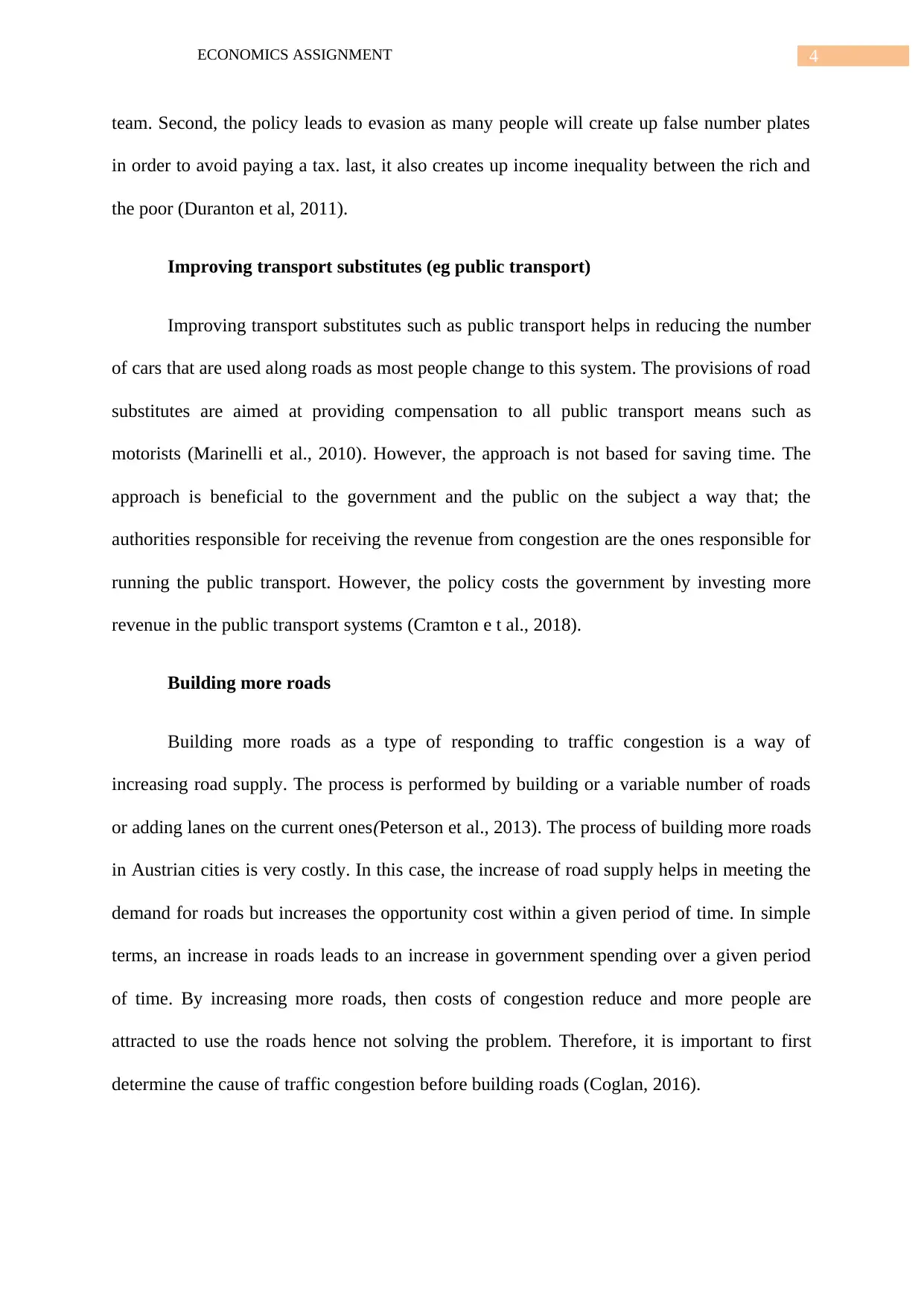
4ECONOMICS ASSIGNMENT
team. Second, the policy leads to evasion as many people will create up false number plates
in order to avoid paying a tax. last, it also creates up income inequality between the rich and
the poor (Duranton et al, 2011).
Improving transport substitutes (eg public transport)
Improving transport substitutes such as public transport helps in reducing the number
of cars that are used along roads as most people change to this system. The provisions of road
substitutes are aimed at providing compensation to all public transport means such as
motorists (Marinelli et al., 2010). However, the approach is not based for saving time. The
approach is beneficial to the government and the public on the subject a way that; the
authorities responsible for receiving the revenue from congestion are the ones responsible for
running the public transport. However, the policy costs the government by investing more
revenue in the public transport systems (Cramton e t al., 2018).
Building more roads
Building more roads as a type of responding to traffic congestion is a way of
increasing road supply. The process is performed by building or a variable number of roads
or adding lanes on the current ones(Peterson et al., 2013). The process of building more roads
in Austrian cities is very costly. In this case, the increase of road supply helps in meeting the
demand for roads but increases the opportunity cost within a given period of time. In simple
terms, an increase in roads leads to an increase in government spending over a given period
of time. By increasing more roads, then costs of congestion reduce and more people are
attracted to use the roads hence not solving the problem. Therefore, it is important to first
determine the cause of traffic congestion before building roads (Coglan, 2016).
team. Second, the policy leads to evasion as many people will create up false number plates
in order to avoid paying a tax. last, it also creates up income inequality between the rich and
the poor (Duranton et al, 2011).
Improving transport substitutes (eg public transport)
Improving transport substitutes such as public transport helps in reducing the number
of cars that are used along roads as most people change to this system. The provisions of road
substitutes are aimed at providing compensation to all public transport means such as
motorists (Marinelli et al., 2010). However, the approach is not based for saving time. The
approach is beneficial to the government and the public on the subject a way that; the
authorities responsible for receiving the revenue from congestion are the ones responsible for
running the public transport. However, the policy costs the government by investing more
revenue in the public transport systems (Cramton e t al., 2018).
Building more roads
Building more roads as a type of responding to traffic congestion is a way of
increasing road supply. The process is performed by building or a variable number of roads
or adding lanes on the current ones(Peterson et al., 2013). The process of building more roads
in Austrian cities is very costly. In this case, the increase of road supply helps in meeting the
demand for roads but increases the opportunity cost within a given period of time. In simple
terms, an increase in roads leads to an increase in government spending over a given period
of time. By increasing more roads, then costs of congestion reduce and more people are
attracted to use the roads hence not solving the problem. Therefore, it is important to first
determine the cause of traffic congestion before building roads (Coglan, 2016).
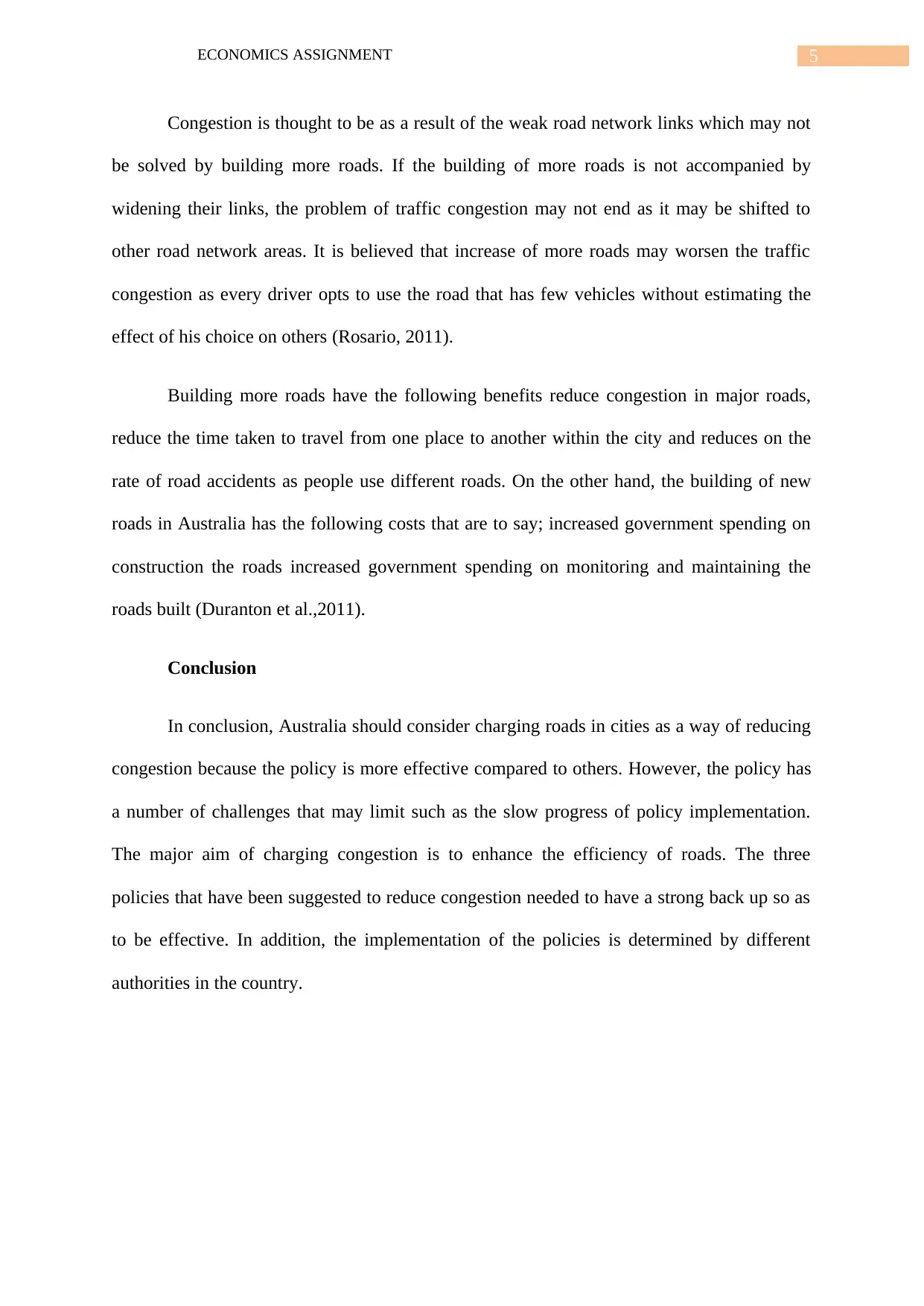
5ECONOMICS ASSIGNMENT
Congestion is thought to be as a result of the weak road network links which may not
be solved by building more roads. If the building of more roads is not accompanied by
widening their links, the problem of traffic congestion may not end as it may be shifted to
other road network areas. It is believed that increase of more roads may worsen the traffic
congestion as every driver opts to use the road that has few vehicles without estimating the
effect of his choice on others (Rosario, 2011).
Building more roads have the following benefits reduce congestion in major roads,
reduce the time taken to travel from one place to another within the city and reduces on the
rate of road accidents as people use different roads. On the other hand, the building of new
roads in Australia has the following costs that are to say; increased government spending on
construction the roads increased government spending on monitoring and maintaining the
roads built (Duranton et al.,2011).
Conclusion
In conclusion, Australia should consider charging roads in cities as a way of reducing
congestion because the policy is more effective compared to others. However, the policy has
a number of challenges that may limit such as the slow progress of policy implementation.
The major aim of charging congestion is to enhance the efficiency of roads. The three
policies that have been suggested to reduce congestion needed to have a strong back up so as
to be effective. In addition, the implementation of the policies is determined by different
authorities in the country.
Congestion is thought to be as a result of the weak road network links which may not
be solved by building more roads. If the building of more roads is not accompanied by
widening their links, the problem of traffic congestion may not end as it may be shifted to
other road network areas. It is believed that increase of more roads may worsen the traffic
congestion as every driver opts to use the road that has few vehicles without estimating the
effect of his choice on others (Rosario, 2011).
Building more roads have the following benefits reduce congestion in major roads,
reduce the time taken to travel from one place to another within the city and reduces on the
rate of road accidents as people use different roads. On the other hand, the building of new
roads in Australia has the following costs that are to say; increased government spending on
construction the roads increased government spending on monitoring and maintaining the
roads built (Duranton et al.,2011).
Conclusion
In conclusion, Australia should consider charging roads in cities as a way of reducing
congestion because the policy is more effective compared to others. However, the policy has
a number of challenges that may limit such as the slow progress of policy implementation.
The major aim of charging congestion is to enhance the efficiency of roads. The three
policies that have been suggested to reduce congestion needed to have a strong back up so as
to be effective. In addition, the implementation of the policies is determined by different
authorities in the country.
⊘ This is a preview!⊘
Do you want full access?
Subscribe today to unlock all pages.

Trusted by 1+ million students worldwide
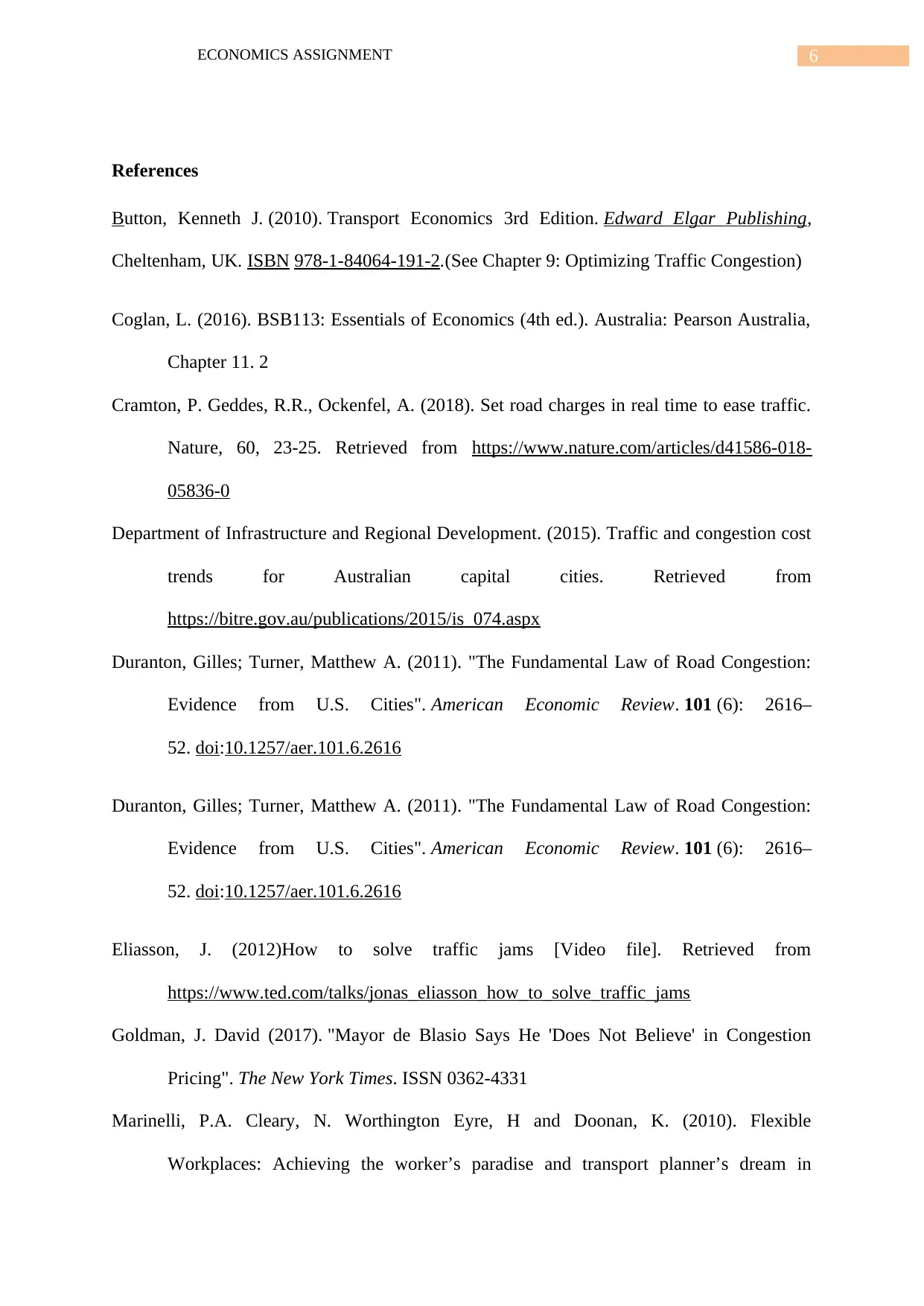
6ECONOMICS ASSIGNMENT
References
Button, Kenneth J. (2010). Transport Economics 3rd Edition. Edward Elgar Publishing,
Cheltenham, UK. ISBN 978-1-84064-191-2.(See Chapter 9: Optimizing Traffic Congestion)
Coglan, L. (2016). BSB113: Essentials of Economics (4th ed.). Australia: Pearson Australia,
Chapter 11. 2
Cramton, P. Geddes, R.R., Ockenfel, A. (2018). Set road charges in real time to ease traffic.
Nature, 60, 23-25. Retrieved from https://www.nature.com/articles/d41586-018-
05836-0
Department of Infrastructure and Regional Development. (2015). Traffic and congestion cost
trends for Australian capital cities. Retrieved from
https://bitre.gov.au/publications/2015/is_074.aspx
Duranton, Gilles; Turner, Matthew A. (2011). "The Fundamental Law of Road Congestion:
Evidence from U.S. Cities". American Economic Review. 101 (6): 2616–
52. doi:10.1257/aer.101.6.2616
Duranton, Gilles; Turner, Matthew A. (2011). "The Fundamental Law of Road Congestion:
Evidence from U.S. Cities". American Economic Review. 101 (6): 2616–
52. doi:10.1257/aer.101.6.2616
Eliasson, J. (2012)How to solve traffic jams [Video file]. Retrieved from
https://www.ted.com/talks/jonas_eliasson_how_to_solve_traffic_jams
Goldman, J. David (2017). "Mayor de Blasio Says He 'Does Not Believe' in Congestion
Pricing". The New York Times. ISSN 0362-4331
Marinelli, P.A. Cleary, N. Worthington Eyre, H and Doonan, K. (2010). Flexible
Workplaces: Achieving the worker’s paradise and transport planner’s dream in
References
Button, Kenneth J. (2010). Transport Economics 3rd Edition. Edward Elgar Publishing,
Cheltenham, UK. ISBN 978-1-84064-191-2.(See Chapter 9: Optimizing Traffic Congestion)
Coglan, L. (2016). BSB113: Essentials of Economics (4th ed.). Australia: Pearson Australia,
Chapter 11. 2
Cramton, P. Geddes, R.R., Ockenfel, A. (2018). Set road charges in real time to ease traffic.
Nature, 60, 23-25. Retrieved from https://www.nature.com/articles/d41586-018-
05836-0
Department of Infrastructure and Regional Development. (2015). Traffic and congestion cost
trends for Australian capital cities. Retrieved from
https://bitre.gov.au/publications/2015/is_074.aspx
Duranton, Gilles; Turner, Matthew A. (2011). "The Fundamental Law of Road Congestion:
Evidence from U.S. Cities". American Economic Review. 101 (6): 2616–
52. doi:10.1257/aer.101.6.2616
Duranton, Gilles; Turner, Matthew A. (2011). "The Fundamental Law of Road Congestion:
Evidence from U.S. Cities". American Economic Review. 101 (6): 2616–
52. doi:10.1257/aer.101.6.2616
Eliasson, J. (2012)How to solve traffic jams [Video file]. Retrieved from
https://www.ted.com/talks/jonas_eliasson_how_to_solve_traffic_jams
Goldman, J. David (2017). "Mayor de Blasio Says He 'Does Not Believe' in Congestion
Pricing". The New York Times. ISSN 0362-4331
Marinelli, P.A. Cleary, N. Worthington Eyre, H and Doonan, K. (2010). Flexible
Workplaces: Achieving the worker’s paradise and transport planner’s dream in
Paraphrase This Document
Need a fresh take? Get an instant paraphrase of this document with our AI Paraphraser
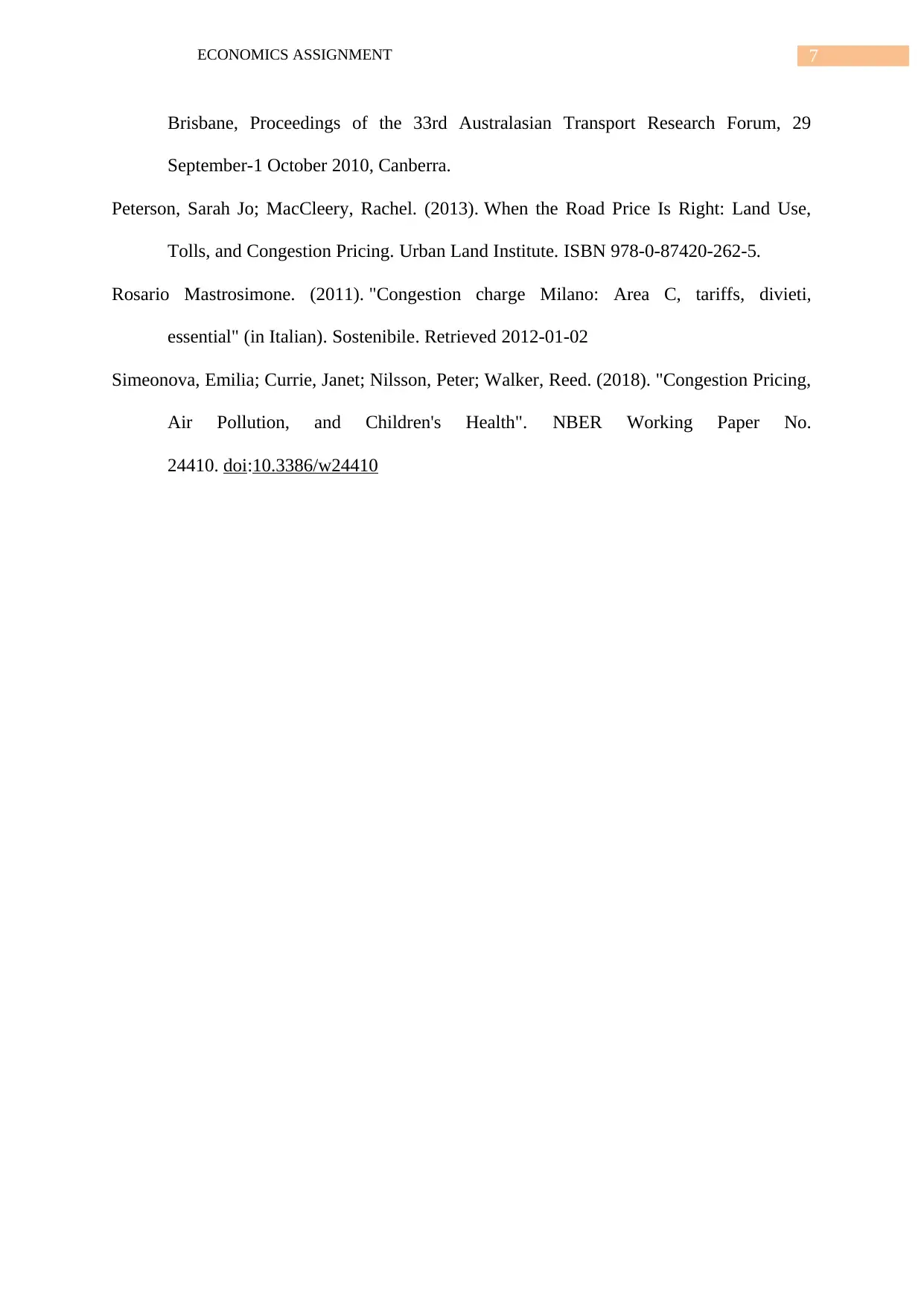
7ECONOMICS ASSIGNMENT
Brisbane, Proceedings of the 33rd Australasian Transport Research Forum, 29
September-1 October 2010, Canberra.
Peterson, Sarah Jo; MacCleery, Rachel. (2013). When the Road Price Is Right: Land Use,
Tolls, and Congestion Pricing. Urban Land Institute. ISBN 978-0-87420-262-5.
Rosario Mastrosimone. (2011). "Congestion charge Milano: Area C, tariffs, divieti,
essential" (in Italian). Sostenibile. Retrieved 2012-01-02
Simeonova, Emilia; Currie, Janet; Nilsson, Peter; Walker, Reed. (2018). "Congestion Pricing,
Air Pollution, and Children's Health". NBER Working Paper No.
24410. doi:10.3386/w24410
Brisbane, Proceedings of the 33rd Australasian Transport Research Forum, 29
September-1 October 2010, Canberra.
Peterson, Sarah Jo; MacCleery, Rachel. (2013). When the Road Price Is Right: Land Use,
Tolls, and Congestion Pricing. Urban Land Institute. ISBN 978-0-87420-262-5.
Rosario Mastrosimone. (2011). "Congestion charge Milano: Area C, tariffs, divieti,
essential" (in Italian). Sostenibile. Retrieved 2012-01-02
Simeonova, Emilia; Currie, Janet; Nilsson, Peter; Walker, Reed. (2018). "Congestion Pricing,
Air Pollution, and Children's Health". NBER Working Paper No.
24410. doi:10.3386/w24410
1 out of 8
Related Documents
Your All-in-One AI-Powered Toolkit for Academic Success.
+13062052269
info@desklib.com
Available 24*7 on WhatsApp / Email
![[object Object]](/_next/static/media/star-bottom.7253800d.svg)
Unlock your academic potential
Copyright © 2020–2025 A2Z Services. All Rights Reserved. Developed and managed by ZUCOL.





